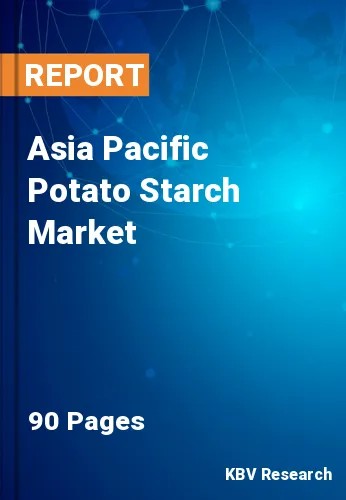The Asia Pacific Potato Starch Market would witness market growth of 4.5% CAGR during the forecast period (2021-2027).
Potato starch is also used for non-food applications such as textile finishing, textile sizing, paper coating, wallpaper adhesive, and gummed tape citation needed. In the mid-1930s, potato starch was used in the color photography process; Autochrome Lumière was designed by the Lumière brothers. Varieties of potatoes species are grown for the production of potato starch with high starch yields and high starch content potatoes are selected for the starch making. Nowadays, potatoes that contain one starch molecule, amylopectin are developed. Amylopectin is also known as a waxy potato starch as it can hold its shape for a long period. It is also produced from the byproduct waste from the potato processing industries during the making of potato chips and French fries.
Potato starch is a flexible ingredient used in the various food product to provide good organoleptic properties. Potato starch is often used in pet foods to provide digestible energy sources for animals. It also improves the texture of the pet food finished during the extrusion and palletization process. Potato starch has the highest viscosity among all the native starches. It easily exhibits the viscosity of 3000 BU at the temperature of 60 to 65 degrees Celsius. At 95 degrees Celsius, potato starch easily touches its highest solubility and swelling powers.
India is the second-largest producer of potatoes, contributing about 12% to world production. Starch production in India is highly fragmented, the small and large manufacturers are producing varieties of starch from different sources. About more than 30 producers in India, manufacture potato starch. The agricultural facilities and access to cold storage facilities can lead to being the greatest manufacturer of potato starch. Indian Potato processing industry emerged due to fast-growing urbanization, expanding market options, and economic liberalization of indigenous processing varieties.
In May 2018 and 2019 China forecasted 400,000 MT, of potato starch, about 25 percent of decrease from May 2017/18. Potato starch is produced by both small and medium-sized organizations in this region. It is one of the most used food products in these regions for multiple purposes. Although, industrial technologies and applications used in manufacturing are rapidly changing.
The China market dominated the Asia Pacific Potato Starch Market by Country in 2020, and would continue to be a dominant market till 2027; thereby, achieving a market value of $282.9 million by 2027. The Japan market is exhibiting CAGR of 3.8% during (2021 - 2027). Additionally, The India market would display a CAGR of 5.1% during (2021 - 2027).
Based on End User, the market is segmented into Food & Beverages (Bakery & Confectionery, Beverages, and Processed Food & Others), Industrial (Paper Industry, Pharma, Cosmetics, Biodegradable Plastics, and Others), and Feed. Based on Type, the market is segmented into Modified and Native. Based on Nature, the market is segmented into Conventional and Organic. Based on countries, the market is segmented into China, Japan, India, South Korea, Singapore, Malaysia, and Rest of Asia Pacific.
Free Valuable Insights: The Worldwide Potato Starch Market is Projected to reach USD 4.9 Billion by 2027, at a CAGR of 3.5%
The market research report covers the analysis of key stake holders of the market. Key companies profiled in the report include Ingredion, Incorporated, Tate & Lyle PLC, AGRANA Beteiligungs-AG, Royal Ingredients Group B.V., Royal Avebe U.A., Sudstrake GmbH, Emsland Group, KMC Ingredients Company, Tereos S.A., and Roquette Freres SA.
By End User
By Type
By Nature
By Country
Our team of dedicated experts can provide you with attractive expansion opportunities for your business.

